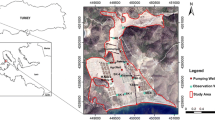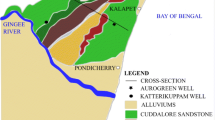Abstract
Oil exploration and development have taken place extensively in the near-shore waters of the Bay of Bengal for over two decades, with onshore coastal aquifers serving as a primary source of water injected into near-shore production wells for enhanced oil recovery. Field and modeling studies were initiated to assess the effects of potential seawater intrusion into the coastal aquifers and to improve strategies for groundwater development and management. Groundwater levels were measured at 42 locations in the central Godavari delta (295 km2) over a period of 2 years (2006–2007). These data indicated that the predominant groundwater flow direction consistently points toward the coast with no significant change in groundwater table elevations during the study period. Groundwater samples analyzed for major ions revealed the groundwater to be brackish in nature with an average salinity of ~5,000 mg L−1. A numerical model of variable density, groundwater flow, and solute transport (SEAWAT) was developed for the study region. After calibrating against observed hydraulic head data for the year 2006 at steady state, the model was used to predict the extent of seawater intrusion in the study area over the next 50 years. The estimated regional groundwater budget indicates a significant amount of groundwater outfall to the Bay of Bengal. The model predicts that the area will not be affected by seawater intrusion at the present rate of groundwater exploitation near the coast.









Similar content being viewed by others
References
Andersen PF, Mercer JW, White O (1988) Numerical modeling of salt-water intrusion at Hallandale, Florida. Ground Water 26(5):619–630. doi:10.1111/j.1745-6584.1988.tb00796.x
Anderson MP, Woessner WW (1992) Applied groundwater modeling, simulation of flow and advective transport. Academic Press, San Diego, California
APHA (2005) Standard methods for the examination of water and wastewater, 21st edn. American Public Health Association, Washington, DC
Bakker M, Oude Essink GHP, Langevin CD (2004) The rotating movement of three immiscible Fluids-a benchmark problem. J Hydrol 287:270–278. doi:10.1016/j.jhydrol.2003.10.007
Bear J, Cheng A, Sorek S, Herrera I, Ouazar D (1999) Seawater intrusion in coastal aquifers: concepts, methods and practices. Kluwer Academic Publishers, Dordrecht
Bobba AG (2002) Numerical modeling of salt-water intrusion due to human activities and sea-level change in the Godavari Delta, India. Hydrol Sci J 47:67–80. doi:10.1080/02626660209493023
Bureau of Indian Standards (BIS) (2012) Indian drinking water standard-spécifications, Manaka Bhavan, 9 Bahadur Shahzafar Marg, New Delhi, 110002, IS 10500:2012. https://law.resource.org/pub/in/bis/S06/is.10500.2012.pdf
CGWB (1999) Groundwater resources and development prospects in East Godavari District, Andhra Pradesh. Ministry of Water Resources, Government of India. Unpublished Report, p 210
Chachadi AG, Teresa L (2002) Health of groundwater regime in costal delta of East Godavari, Andhra Pradesh. Coastin, Coastal Research Newsletter, pp 4–7
Christensen FD, Engesgaard P, Kipp KL (2001) A reactive transport investigation of seawater intrusion experiment in a shallow aquifer, Skansehage, Denmark. In: Proceedings of the first international conference on saltwater intrusion and coastal aquifers, Essaouira, Morocco p 4
Cooper HH Jr, Jacob CE (1946) A generalized graphical method for evaluating formation constants and summarizing well field history. Trans Am Geophys Union 27:526–534. doi:10.1029/TR027i004p00526
Davis SN, Deweist RJM (1966) Hydrogeology. Wiley, New York
De Marsily G (1986) Quantitative hydrogeology: groundwater hydrology for engineers. Academic Press Inc, London, UK
Ding F, Yamashita T, Lee HS, Pan J (2014) A modelling study of seawater intrusion in the LiaoDongBay coastal plain, China. J Mar Sci Technol 22(2):103–115. doi:10.6119/JMST-012-0220-1
Ferguson G, Gleeson T (2012) Vulnerability of coastal aquifers to groundwater use and climate change. Nat Clim Change 2(5):342–345. doi:10.1038/nclimate1413
Geological Society of India (GSI) (2006) Miscellaneous publication no.30, Part VII 2nd revised edition. Geology and Mineral Resources of Andhra Pradesh, p 91
Groundwater Resources Estimation (GEC) Methodology (2009) Ministry of Water Resources, Government of India, New Delhi, pp 1–107
Guo W, Langevin CD (2002) User’s guide to SEAWAT: A computer program for simulation of three dimensional variable density groundwater flow. US Geological Survey TWRI Book 6, Chapter 7, p 79
Gurunadha Rao VVS, Kiranmayi B, Ramesh M, Surinaidu L, Thamma Rao G, Mahesh J, Umamaheswari A, Rajasekhar B, Prakash BA (2008) Assessment of Groundwater Quality around Ravva On-Shore Terminal, Central Godavari Delta, East Godavari District, A.P., Tech Rep. No. NGRI-2008-Environ-654, p 41
Gurunadha Rao VVS, Thammarao G, Surinaidu L, Rajesh R, Mahesh J (2011) Geophysical and geochemical approach for seawater intrusion assessment in the Godavari Delta basin, A.P., India. Water Air Soil Pollut 217(1–4):503–514. doi:10.1007/s11270-010-0604-9
Gurunadha Rao VVS, Tamma Rao G, Surinaidu L, Mahesh J, Mallikharjuna Rao TS, Mangaraja Rao B (2013) Assessment of geochemical processes occurring in ground waters in the coastal alluvial aquifer. Environ Monit Assess 185(10):8259–8272. doi:10.1007/s10661-013-3171-x
Harbaugh AW (2005) MODFLOW-2005, the U.S. Geological Survey Modular Ground-Water Model—the Ground-Water Flow Process: U.S. Geological Survey Techniques and Methods 6-A16, variously
Harbaugh AW, McDonald MG (1996) User’s documentation for MODFLOW-96, an update to the U.S. Geological Survey modular finite-difference ground-water flow model: U.S. Geological Survey Open-File. Report 96–485(56):10
Harbaugh AW, Banta ER, Hill MC, McDonald MG (2000) MODFLOW-2000, the U.S. Geological Survey modular ground-water model—user guide to modularization concepts and the ground-water flow process: U.S. Geological Survey open-file report, 00-92, 121 p
Kumar M, Kumari K, Ramanathan AL, Saxena R (2007) A comparative evaluation of groundwater suitability for irrigation and drinking purposes in two agriculture dominated districts of Punjab, India. J Environ Geol 53(3):553–574. doi:10.1007/s00254-007-0672-3
Lagudu S, Rao VVSG, Prasad PR, and Sarma VS (2013) Use of geophysical and hydrochemical tools to investigate seawater intrusion in coastal alluvial aquifer, Andhra Pradesh, India. In groundwater in the coastal zones of Asia-Pacific, Springer Netherlands pp 49–65. doi:10.1007/978-94-007-5648-9_4
Langevin CD, Guo W (2006) MODFLOW/MT3DMS-Based simulation of variable density groundwater flow and transport. Groundwater 44(3):339–351. doi:10.1111/j.1745-6584.2005.00156.x
Langevin CD, Shoemaker WB, Guo W (2003) MODFLOW-2000, the U.S. Geological Survey Modular Ground-Water Model-Documentation of the SEAWAT-2000 version with the Variable density flow process (VDF) and the integrated MT3DMS Transport Process (IMT).USGS Open-File Report 03-426
Lin J, Snodsmith JB, Zheng CM, Wu JF (2009) A modeling study of seawater intrusion in Alabama Gulf Coast, USA. Environ Geol 57(1):119–130. doi:10.1007/s00254-008-1288-y
McDonald MG, Harbaugh AW (1988) A modular three dimensional finite difference groundwater flow model. US Geological Survey Open—File Report 83–875
McDonald MG, Harbaugh AW (2003) Ground Water 41(2):273–279. doi:10.1111/j.1745-6584.2003.tb02591.x
Naidu LS, G Rao VVS, T Rao G, Mahesh J, Padalu G, Sarma VS, Prasad PR, Rao SM, R Rao BM (2013) An integrated approach to investigate saline water intrusion and to identify the salinity sources in the Central Godavari delta, Andhra Pradesh, India. Arab J Geosci 6(10):3709-3724 DOI: 10.1007/s12517-012-0634-2
Rao GN (1993) Geology and hydrocarbon prospects of sea coast sedimentary basins of India with special reference to Krishna Godavari Basin. J Geo Soc India 41(2):444–445
Rengamannar V, Pradhan PK (1991) Geomorphology and evolution of Godavari delta. Geol Soc India Memoir 22:51–56
Sastri VV, Singh, Murti KVS (1973) Stratigraphy and tectonics of sedimentary basins of East Coast of Peninsular India. Bull AAPG 57:6
Seetaramaswamy A, Poornachandra Rao M (1975) Distribution of certain chemical constituents of the Krishna river. J Indian Acad Geosci 18:2
Subramanian V, Saxena K (1983) Hydrogeology of ground water in Delhi region of India, Relation of water quality and quantity. Proceedings of the Hamberg symposium, IAHS publication no 146
Surinaidu L, Gurunadha Rao VVS, Ramesh G (2013a) Assessment of groundwater inflows into Kuteshwar Limestone Mines through flow modeling study, Madhya Pradesh, India. Arab J Geosci 6(4):1153–1161. doi:10.1007/s12517-011-0421-5
Surinaidu L, Bacon CGD, Pavelic P (2013b) Agricultural groundwater management in the Upper Bhima Basin, India: current status and future scenarios Hydrol Earth Syst Sci 17:507–517. doi:10.5194/hess-17-507-2013
Zheng C (1990) MT3D, a modular three-dimensional transport model for simulation of advection, dispersion and chemical reactions of contaminants in groundwater systems, report to the U.S. Environmental Protection Agency Robert S. Kerr Environmental Research Laboratory, Ada, Oklahoma
Zheng C, Bennett GD (2002) Applied contaminant transport modeling, 2nd edn. Wiley, New York
Zheng C, Wang PP (1999) MT3DMS- A modular three dimensional multi species transport model for simulation of advection, dispersion and chemical reactions of contaminants in groundwater systems; Documentation and user’s guide: US Army Corps of Engineers Contract Report SERDP-99-1
Zimmermann S, Bauer P, Held R, Kinzelbach W, Walthe JH (2006) Salt transport on islands in the Okavango Delta: numerical investigations. Adv Water Resour 29(1):11–29. doi:10.1016/j.advwatres.2005.04.013
Acknowledgments
The authors are grateful to the Director, CSIR–National Geophysical Research Institute, Hyderabad, for his kind permission to publish the paper. We are also thankful to Dr. Paul Pavelic, International Water Management Institute (IWMI), Hyderabad, for his critical inputs and editing the manuscript. The time provide by IWMI to write this paper is highly appreciated. We thank Dr. Virginia Burkett, United States Geological Survey (USGS) for her useful suggestions and language editing to improve quality of the paper.
Author information
Authors and Affiliations
Corresponding author
Additional information
Editor: Virginia R. Burkett.
Rights and permissions
About this article
Cite this article
Surinaidu, L., Gurunadha Rao, V.V.S., Mahesh, J. et al. Assessment of possibility of saltwater intrusion in the central Godavari delta region, Southern India. Reg Environ Change 15, 907–918 (2015). https://doi.org/10.1007/s10113-014-0678-9
Received:
Accepted:
Published:
Issue Date:
DOI: https://doi.org/10.1007/s10113-014-0678-9




